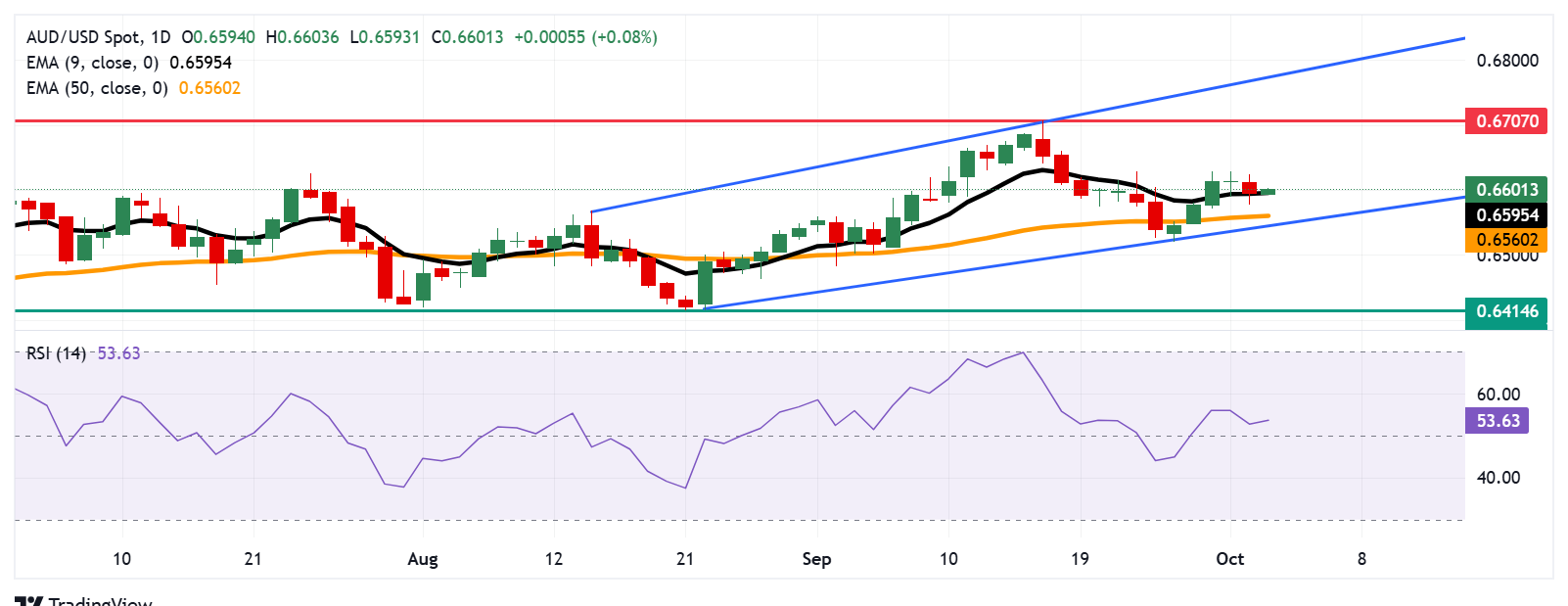Created
: 2025.10.03














![]() 2025.10.03 11:09
2025.10.03 11:09
The Australian Dollar (AUD) holds ground against the US Dollar (USD) on Friday after registering losses in the previous session. The AUD/USD pair remains steady following the release of S&P Global Purchasing Managers' Index (PMI) data.
The S&P Global Australia Composite PMI fell to 52.4 in September from 55.5 in August, marking a full year of monthly growth but at the slowest pace since June. Meanwhile, the Services PMI declined to 52.4 from 55.8, signaling continued expansion in the services sector for the 20th straight month, though also at its weakest rate since June.
Australia's Trade Surplus narrowed to 1,825 million month-over-month (MoM) in August, against 6,500 million expected and 7,310 million in the previous reading. Meanwhile, Exports fell by 7.8% MoM in August from 3.3% seen a month earlier as Gold exports declined after a run of strong months. Imports rose by 3.2% MoM in August, compared to a decline of 1.3% seen in July.
The Reserve Bank of Australia (RBA) said in its semi-annual Financial Stability Review (FSR) on Thursday that risks emerge from elevated asset prices and stress in sovereign debt markets. It noted that highly leveraged trades and the expansion of the non-bank sector are increasing market vulnerabilities. The RBA also warned that weakness in China's property sector is weighing on banks and is likely to persist.
The RBA kept its Official Cash Rate (OCR) unchanged at 3.6% at the September monetary policy meeting. RBA Governor Michele Bullock said at a post-meeting press conference that components of the monthly CPI are a little higher than expected, and inflation is not running away.
The AUD/USD pair is trading around 0.6590 on Friday. Technical analysis on the daily chart shows that the pair remains within the ascending channel, indicating a prevailing bullish bias. Additionally, the 14-day Relative Strength Index (RSI) is positioned slightly above the 50 level, suggesting the bullish bias is active.
On the upside, the AUD/USD pair targets the psychological level of 0.6600. A break above this level may prompt the pair to explore the region around the 12-month high of 0.6707, recorded on September 17, followed by the upper boundary of the ascending channel around 0.6760.
The nine-day Exponential Moving Average (EMA) at 0.6595 is acting as immediate support, followed by the 50-day EMA at 0.6560 and the ascending channel's lower boundary around 0.6550. Further declines below the channel would likely trigger the emergence of a bearish bias and put downward pressure on the AUD/USD pair, potentially navigating the region around the fourth-month low of 0.6414, recorded on August 21.

The table below shows the percentage change of Australian Dollar (AUD) against listed major currencies today. Australian Dollar was the strongest against the Japanese Yen.
| USD | EUR | GBP | JPY | CAD | AUD | NZD | CHF | |
|---|---|---|---|---|---|---|---|---|
| USD | -0.12% | -0.11% | 0.16% | -0.05% | -0.14% | -0.14% | -0.07% | |
| EUR | 0.12% | 0.07% | 0.28% | 0.09% | -0.02% | -0.03% | 0.06% | |
| GBP | 0.11% | -0.07% | 0.24% | -0.00% | -0.08% | -0.09% | -0.02% | |
| JPY | -0.16% | -0.28% | -0.24% | -0.21% | -0.32% | -0.32% | -0.26% | |
| CAD | 0.05% | -0.09% | 0.00% | 0.21% | -0.07% | -0.08% | -0.02% | |
| AUD | 0.14% | 0.02% | 0.08% | 0.32% | 0.07% | -0.01% | 0.06% | |
| NZD | 0.14% | 0.03% | 0.09% | 0.32% | 0.08% | 0.00% | 0.06% | |
| CHF | 0.07% | -0.06% | 0.02% | 0.26% | 0.02% | -0.06% | -0.06% |
The heat map shows percentage changes of major currencies against each other. The base currency is picked from the left column, while the quote currency is picked from the top row. For example, if you pick the Australian Dollar from the left column and move along the horizontal line to the US Dollar, the percentage change displayed in the box will represent AUD (base)/USD (quote).
One of the most significant factors for the Australian Dollar (AUD) is the level of interest rates set by the Reserve Bank of Australia (RBA). Because Australia is a resource-rich country another key driver is the price of its biggest export, Iron Ore. The health of the Chinese economy, its largest trading partner, is a factor, as well as inflation in Australia, its growth rate and Trade Balance. Market sentiment - whether investors are taking on more risky assets (risk-on) or seeking safe-havens (risk-off) - is also a factor, with risk-on positive for AUD.
The Reserve Bank of Australia (RBA) influences the Australian Dollar (AUD) by setting the level of interest rates that Australian banks can lend to each other. This influences the level of interest rates in the economy as a whole. The main goal of the RBA is to maintain a stable inflation rate of 2-3% by adjusting interest rates up or down. Relatively high interest rates compared to other major central banks support the AUD, and the opposite for relatively low. The RBA can also use quantitative easing and tightening to influence credit conditions, with the former AUD-negative and the latter AUD-positive.
China is Australia's largest trading partner so the health of the Chinese economy is a major influence on the value of the Australian Dollar (AUD). When the Chinese economy is doing well it purchases more raw materials, goods and services from Australia, lifting demand for the AUD, and pushing up its value. The opposite is the case when the Chinese economy is not growing as fast as expected. Positive or negative surprises in Chinese growth data, therefore, often have a direct impact on the Australian Dollar and its pairs.
Iron Ore is Australia's largest export, accounting for $118 billion a year according to data from 2021, with China as its primary destination. The price of Iron Ore, therefore, can be a driver of the Australian Dollar. Generally, if the price of Iron Ore rises, AUD also goes up, as aggregate demand for the currency increases. The opposite is the case if the price of Iron Ore falls. Higher Iron Ore prices also tend to result in a greater likelihood of a positive Trade Balance for Australia, which is also positive of the AUD.
The Trade Balance, which is the difference between what a country earns from its exports versus what it pays for its imports, is another factor that can influence the value of the Australian Dollar. If Australia produces highly sought after exports, then its currency will gain in value purely from the surplus demand created from foreign buyers seeking to purchase its exports versus what it spends to purchase imports. Therefore, a positive net Trade Balance strengthens the AUD, with the opposite effect if the Trade Balance is negative.
![]()
Created
: 2025.10.03
![]()
Last updated
: 2025.10.03

FXStreet is a forex information website, delivering market analysis and news articles 24/7.
It features a number of articles contributed by well-known analysts, in addition to the ones by its editorial team.
Founded in 2000 by Francesc Riverola, a Spanish economist, it has grown to become a world-renowned information website.
We hope you find this article useful. Any comments or suggestions will be greatly appreciated.
We are also looking for writers with extensive experience in forex and crypto to join us.
please contact us at [email protected].
Disclaimer:
All information and content provided on this website is provided for informational purposes only and is not intended to solicit any investment. Although all efforts are made in order to ensure that the information is correct, no guarantee is provided for the accuracy of any content on this website. Any decision made shall be the responsibility of the investor and Myforex does not take any responsibility whatsoever regarding the use of any information provided herein.
The content provided on this website belongs to Myforex and, where stated, the relevant licensors. All rights are reserved by Myforex and the relevant licensors, and no content of this website, whether in full or in part, shall be copied or displayed elsewhere without the explicit written permission of the relevant copyright holder. If you wish to use any part of the content provided on this website, please ensure that you contact Myforex.
Myforex uses cookies to improve the convenience and functionality of this website. This website may include cookies not only by us but also by third parties (advertisers, log analysts, etc.) for the purpose of tracking the activities of users. Cookie policy